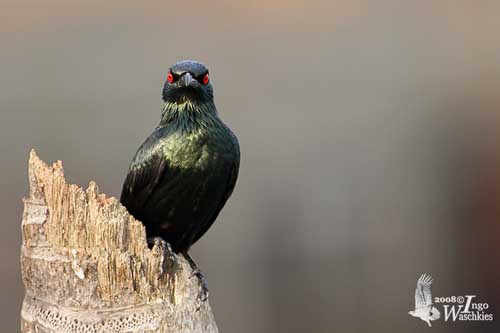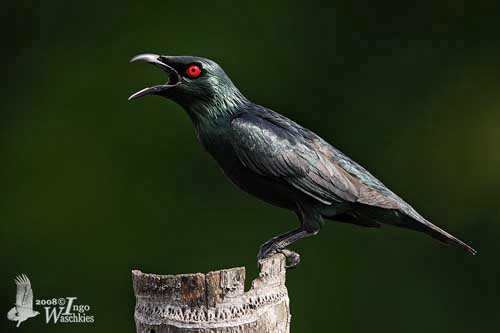
Fr: Stourne bronze
All : Malaienstar
Esp: Estornino Bronceado
Ital: Storno splendente delle Filippine
Nd: Maleise Purperspreeuw
Sd: Orientstare
Photographer:
Ingo Waschkies
My bird pictures on Pbase
Text by Nicole Bouglouan
Sources:
HANDBOOK OF THE BIRDS OF THE WORLD Vol 14 by Josep del Hoyo-Andrew Elliot-David Christie - Lynx Edicions – ISBN: 9788496553507
BirdLife International (BirdLife International)
Sungei Buloh Wetlands Reserve (Michael Mastaller)
Wikipedia, the free encyclopaedia
Asian Glossy Starling
Aplonis panayensis
Passeriforme Order – Sturnidae Family
BIOMETRICS:
Length: 20 cm
Weight: 50-60 g
DESCRIPTION:
The Asian Glossy Starling often appears black, but the conspicuous bright red eyes light up the glossy plumage of this beautiful bird.
Both sexes are similar.
The adult has black plumage with greenish gloss overall, except on vent which is matt black.
On the head, we can see a small black mask on the lores and around the eye. Nape and neck exhibit more elongated feathers which are fluffed up according to the situation and the mood of the bird.
The strong bill, legs and feet are black. The eyes are bright red.

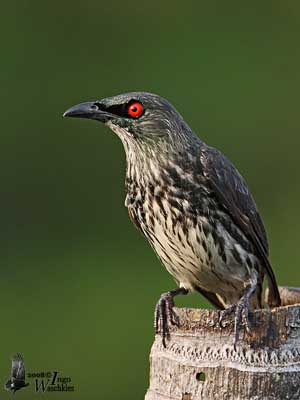
The juvenile has dark brown upperparts with weak green gloss on the upperwing. The underparts are whitish with dark streaks. The eyes are yellow, orange or pink. The colour changes little by little while the bird is growing up, as it gains the green gloss on its plumage.
Here is an immature -------------------->
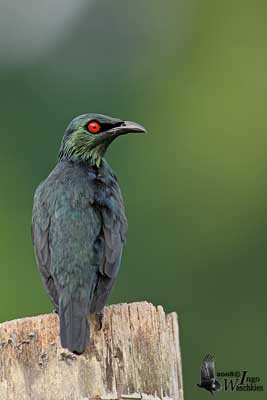
There are 14 subspecies which slightly differ in size of both body and bill, intensity of the greenish gloss and colour of the eyes from whitish and pink to orange and red.
The race displayed on this page is the subspecies Aplonis panayensis strigata from Singapore. This one is smaller than nominate. Its plumage shows rather bluish to blackish-green wash on the upperparts, and more greenish gloss below.
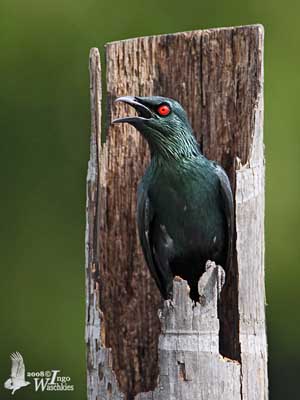
VOICE:
The Asian Glossy Starling utters metallic calls. When perched, it gives a metallic “ink”. At roost, they give high-pitched trills. In flight, they utter noisy piping or ringing whistles. We can also hear shrill “tseeu”, repeated “tsuu tsuu” and descending “tseeeer”. They are noisy when in groups.
Any true song reported, but they are able to mimic the calls of other bird species.
HABITAT:
The Asian Glossy Starling frequents forest, including edges and clearings, secondary growths, mangroves, coastal vegetation, gardens and plantations. It is usually seen from the lowlands up to 700 metres of elevation, but not higher.
They often roost in urban areas. These roosts may contain up to 15, 000 birds and they often gather with Common Mynas and White-vented Mynas.
RANGE:
The Asian Glossy Starling occurs in Bangladesh, Brunei, India, Indonesia, Malaysia, Myanmar, the Philippines, Singapore and Thailand.
BEHAVIOUR:
The Asian Glossy Starling is mainly a fruit-eater, feeding on great variety of fruits species, and especially figs, papaya, banana and mangos. It also takes berries and nuts. It sometimes catches insects, spiders and snails, and may also feed on nectar from fruiting trees.
This arboreal bird forages often in treetops, but it will eat the fallen fruits on the ground where it also catches grasshoppers. It can hawk flying insects in the air.
In Malay Peninsula, there are some reports of birds feeding on large snails and smashing them against hard surface to break the shells.
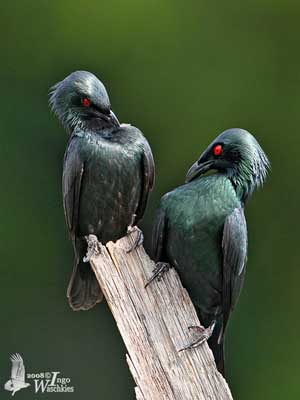
The Asian Glossy Starling is highly gregarious and they often forage and roost in flock of about 20 birds or more. Before to reach the roost, they often perform some displays over the roosting tree. The flock moves quickly and performs impressive twists, and may also form symmetrical pattern. These complex aerial displays could be used as predator-avoidance strategy. Such flocks are more stable and are less likely to split up, leaving some isolated and vulnerable individuals.
They perform regular preening which is the main part of feathers’ maintenance, but also an important element in social behaviour between them.
The Asian Glossy Starling is mainly resident in its range, and only performs some local movements. However, some dispersal can be over fairly long distances to find fruiting trees, and they travel in nocturnal movements.
FLIGHT:
The Asian Glossy Starling performs direct and fast flight, usually at treetop level.
REPRODUCTION:
The breeding season varies according to the range.
The Asian Glossy Starling is probably monogamous and sometimes colonial breeder.
It is a cavity-nester, using old woodpeckers’ hole in tree, a hole in cliff or bank, sometimes a hollow in wall or even in nest-box. The rough cup is built in the hole and made with roots, grass and leaves, often high above the ground.
The female lays 3 bluish eggs with dark markings.
The nesting behaviour of this species is currently unknown.
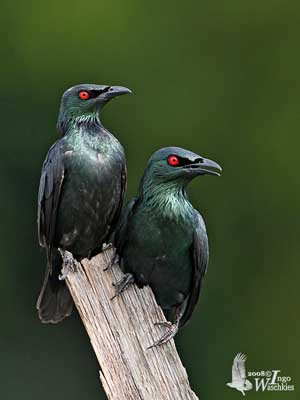
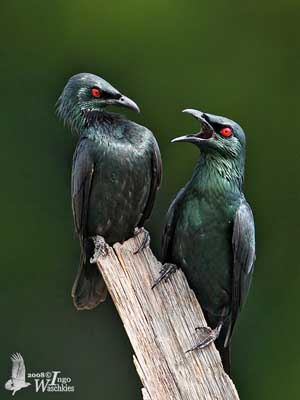
DIET:
The Asian Glossy Starling feeds on fruits from numerous trees’ species. It also takes berries and nuts, and nectar from the fruiting trees.
It catches insects such as beetles, adults and larvae, caterpillars, mole-crickets and immature grasshoppers.
It forages mainly in trees, but it takes the fallen fruits on the ground.
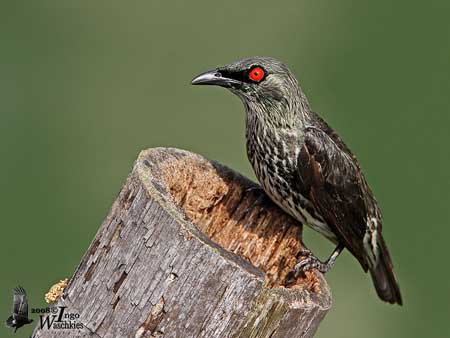
PROTECTION / THREATS / STATUS:
The Asian Glossy Starling is common and widespread, and well adapted to human developments. Large flocks often occur in urban areas.
They are trapped for food in the Philippines. Although the species is an important agent in the dispersal of seeds of trees, it is also considered a pest of crops and orchards.
The species is not currently threatened.
